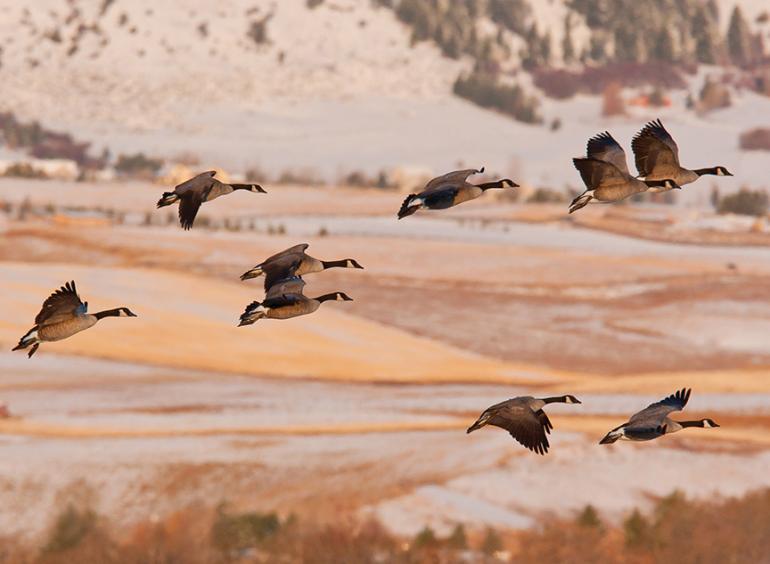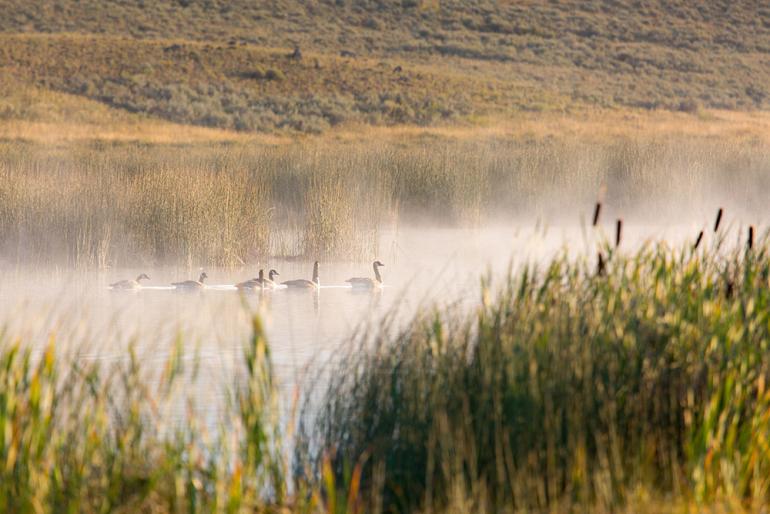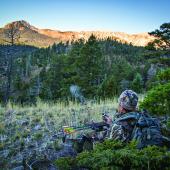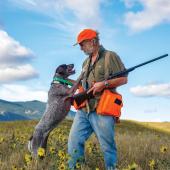Wild Goose Chase
Wings in the Sky.
It’s a bitter winter afternoon near Bozeman, and I’m already fantasizing about a hot shower and a glass of cabernet. Snow has been falling steadily, and a layer of cold fog lays across the countryside like a blanket. My wife Lori and I have just finished collecting the decoys and started to posthole our way back through the snow toward our truck. Kenai, our big yellow Lab, is too tired to frolic, for Lori and I are each carrying limits of greenheads and he has been a busy boy.
Suddenly, I stop in my tracks. We’ve been listening to high-flying geese all day, but this time the distinctive honk that gives Canada geese their nickname sounds deep and resonant. I can’t see the birds through the fog, but my ears have already told me these are flying our way at low altitude.
“Get down!” I whisper to Lori. Then I fumble for the goose call that has been hanging uselessly around my neck and call just as the geese appear. My honk steers them in our direction, and their new vector is going to put them right over our heads just off the deck. “Don’t shoot until they’re directly overhead,” I advise. Then it’s “Take ’em!” and we do.
Kenai may be wet and tired, but he still has enough energy left to run down two future goose dinners.
Habitat
Most waterfowl hunters start with ducks, which are more numerous and easier to hunt than geese. This discussion focuses on the differences between duck hunting and goose hunting for the benefit of those ready to take their waterfowling to the next level.
Geese prefer larger landscapes than ducks—lakes rather than ponds (before they have frozen) and big rivers rather than creeks after that. Geese often congregate along the Missouri, Yellowstone, and Big Horn after ice-up, although they may travel miles to feed each day. But you can run into geese over open water anywhere, so always go prepared.
Geese love to feed in large, open grain fields. When geese are migrating through Montana, I commonly see flocks of hundreds cautiously circling stubble before committing to land. The lack of cover in this terrain makes them especially difficult to hunt.
Behavior
First, a clarification. Canadian honkers aren’t Montana’s only geese. A trip to Freezout Lake north of Great Falls during the spring migration allows observers to enjoy one of nature’s great spectacles as thousands of snow geese congregate on their way north to their tundra breeding grounds. Many “snows” either over-fly Montana or bypass it completely in the fall. In 2016, thousands died after landing on toxic water in Butte’s Berkeley Pit. Speckle-bellies (properly known as white-fronted geese) are a personal favorite because of their table quality, but not many show up in Montana during the fall. We’ll confine this discussion to Canada geese, since that’s the species hunters are most likely to encounter.
Geese fly in larger flocks and at higher altitudes than ducks, two traits that make them harder to hunt. I always look forward to a private annual event I call Goose Day, when thousands of southbound geese suddenly appear high overhead during the first week of November. Most will never descend within shotgun range of the ground, but a week of goose talk from the sky provides a natural way to confirm winter’s onset.
Small flocks of geese are more likely to appear close to the ground, and lost singles are especially likely to respond to a call. The important point is that most of the geese hunters see are likely out of range and should be left alone. “Sky-busting”—shooting at geese that are too high up—is unethical, bad for geese, and bad for hunting.
Gear
Serious goose hunters routinely set out dozens if not hundreds of decoys for morning field shoots. While white rags will lure snow geese into range, honker hunting requires something more realistic. Plastic or fiberboard shells with detachable heads are convenient, because they are lightweight and stack easily. One or two floating decoys beside a duck spread on open water can be enough to attract single geese. Remember that mechanized motion decoys are illegal in Montana.
Geese respond to calls better than ducks, in my opinion. Countless goose calls are available on the market, ranging in quality from cheap plastic squawkers to exquisite wooden models that belong in museums rather than hanging from my neck. No matter whether I’m calling mallards or moose, I think the setup is more important than the sound the call makes.
I’ve long been a contrarian about shotguns, arguing that most hunters use more gun than they need. Geese are an exception. They are hard to kill, and are usually farther away than they appear. Geese call for full-choked 12-gauges and shot no smaller than #2 at a minimum, with BBs preferred.
Discipline and judgement allow for exceptions. Shooting ducks at close range over decoys, I often carry a 20-gauge, as Lori and I were doing that day outside Bozeman. If the geese hadn’t been directly overhead at point-blank range, we wouldn’t have shot at all.
We won’t discuss clothing in detail, except to remind readers that few places on earth are colder than a frozen pit blind in a windswept stubble field.
Regs
Like all migratory-bird regulations, goose seasons and limits are set by the federal Fish and Wildlife Service. Remember that in addition to a Montana license with a waterfowl endorsement, you need a duck stamp to hunt geese.
Goose season generally begins in early October, for both the Central and Pacific flyways, and ends in January. Dates vary between the two, so always check the current regulations.
Because the continental population of snow geese has skyrocketed to levels that threaten their summer habitat, limits on light geese (snows and closely related Ross’s geese) have expanded to 20 per day. The daily limit on dark geese is four.
While I’ve done my share of “serious” goose hunting—a hundred decoys set out around a miserable layout blind in a field of wheat stubble—most of the Montana geese I kill each year are taken more or less by accident. Perhaps you’ve done the work necessary to enjoy the sight of 50 geese cupping their wings on final approach to your decoys in a field. Perhaps you’ve just carried a goose call and a pair of heavy loads on a routine duck hunt and been lucky. Either option can make you a Montana goose hunter.
Save for some time spent in Alaska, Don Thomas has lived in central Montana for over 40 years, and his wife Lori is a fourth-generation Montanan. Don has raised and trained retrievers for decades, and he and Lori have written about and photographed waterfowl hunting for numerous national publications.













